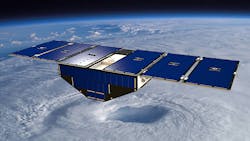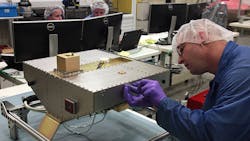After completing a series of design reviews earlier this year, the National Aeronautics and Space Administration (NASA) has begun the assembly of its new fleet of hurricane-observing satellites. The Cyclone Global Navigation Satellite System (CYGNSS) will consist of eight microsatellites in low-earth orbit, monitoring tropical storms, hurricanes, and typhoons throughout their lifecycle.
The CGYNSS satellite network was not designed to be an independent system, but rather to harness signals from existing GPS satellites. By analyzing both direct and reflected GPS signals, the microsatellites give meteorologists access to the inner core of severe weather patterns. The direct signals serve to pinpoint satellite positions, while the reflected signals measure the roughness of the ocean’s surface, from which wind speed and other data points can be estimated. Each satellite is capable of measuring four simultaneous reflections, resulting in 332 wind measurements per second.
The data generated by the satellites will significantly enhance hurricane forecasting, providing more accurate predictions of hurricane tracks, intensities, and storm surges. CYGNSS will measure surface winds in the hurricane’s inner depths, including the eye wall and intense inner rain bands—regions that scientists have never been able to measure from space. The CYGNSS wind measurements, coupled with precipitation data, will open new insights into moist atmospheric thermodynamics and hurricane behavior, according to the University of Michigan, which directed the design and production of the satellites.
The main advantage of the CYGNSS network is in the large number of measurements it can make. For instance, the interaction of GPS and CYGNSS satellites will produce a new image of wind speeds over the entire tropics every few hours. On the other hand, it would take a single satellite a few days to generate the same information. Successive microsatellites will pass over the same region of the earth approximately every 12 minutes, according to NASA. The eight microsatellites, each slightly larger than a standard carry-on suitcase, will be deployed in a 500-km orbit and at an inclination of about 35 deg.
The design reviews marked “the end of the detailed design and planning stage of the [CYGNSS] mission and the beginning of flight hardware assembly,” says Chris Ruf, CYGNSS principal investigator at the University of Michigan, Ann Arbor. The Southwest Research Institute in San Antonio is building and testing the CYGNSS microsatellites and will host the mission operations center at its Boulder, Colo. facility.
The satellites are expected to be ready for testing in early 2016. The mission is scheduled to launch late next year on an Orbital ATK Pegasus XL rocket from the Cape Canaveral Air Force Station in Florida. NASA officials have said that scientific operations are scheduled to begin with the Atlantic hurricane season in 2017.
About the Author

James Morra
Senior Editor
James Morra is the senior editor for Electronic Design, covering the semiconductor industry and new technology trends, with a focus on power electronics and power management. He also reports on the business behind electrical engineering, including the electronics supply chain. He joined Electronic Design in 2015 and is based in Chicago, Illinois.

